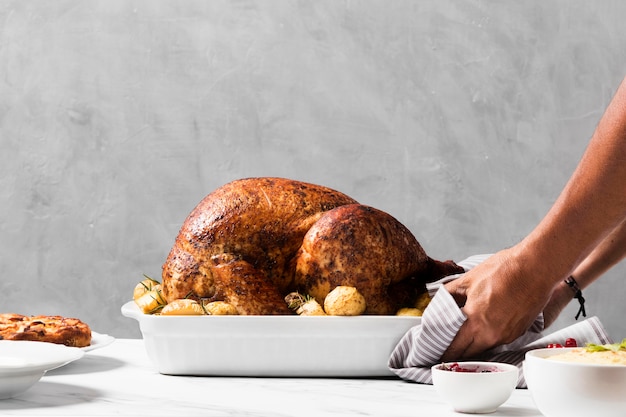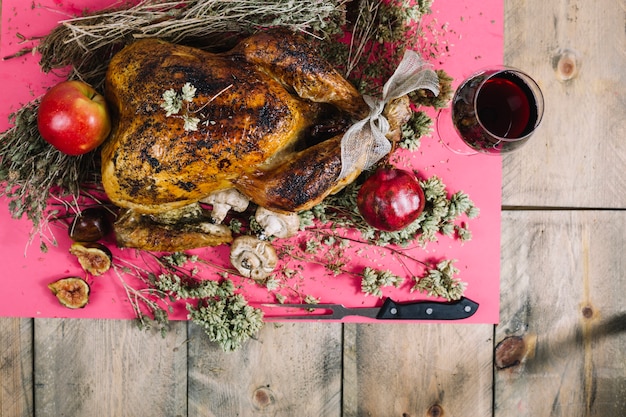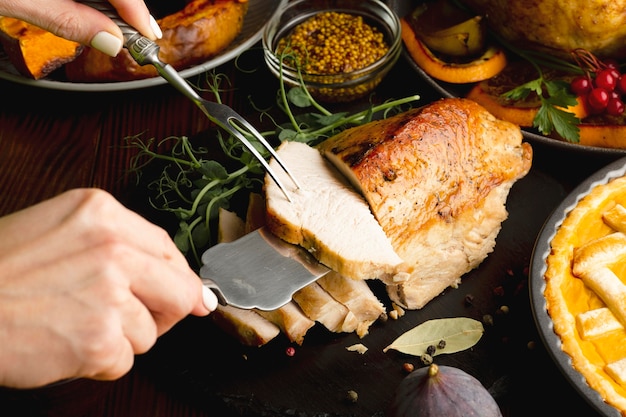Right, let's talk about bottom round roast, shall we? It's a cut of beef that often gets overlooked, but it's truly a hidden gem if you know how to cook it right. I've been a bit of a meat fanatic for years, and I've tried my fair share of bottom round roasts – some dry and disappointing, others melt-in-your-mouth masterpieces. And trust me, the difference is night and day. It's all about the technique. So, buckle up, because I'm about to share all the secrets I've learned along the way to help you cook up a bottom round roast that'll have everyone asking for seconds.
(Part 1) Understanding the Cut

Before we dive into the cooking, let's get acquainted with our star ingredient: the bottom round roast. This cut comes from the hindquarters of the cow, specifically the lower portion of the round. It's known for being lean and flavorful, but it can also be a bit tough if not cooked properly. Don't let that put you off! With the right approach, this humble cut can become the hero of your next dinner party.
The Good, The Bad, and the Tough: Exploring the Bottom Round Roast's Characteristics
Every cut of meat has its strengths and weaknesses. With the bottom round roast, it's all about understanding its unique characteristics. It's lean, which means less fat, which translates to a healthier option. Plus, it's packed with flavour, giving you that delicious beefy taste we all crave. However, being lean also means it can be prone to drying out, which is why we need to be extra careful when cooking it. But don't worry, I've got you covered with plenty of tips and tricks to ensure your bottom round roast stays juicy and tender.
choosing the right cut: A Guide for Success
Not all bottom round roasts are created equal. When choosing your cut, look for one that's well-marbled, meaning it has streaks of fat throughout. This will help keep the meat moist and flavorful during cooking. Avoid cuts that are too thin or have too much connective tissue, as these will be more difficult to cook evenly and may end up tough. And if you're really serious about your roast, go for a "bottom round eye of round," which is the most tender cut from this region. It's a bit pricier, but trust me, it's worth it for the exceptional tenderness it delivers!
(Part 2) Mastering the Art of slow cooking

Now, we've talked about the cut, but let's get to the heart of the matter: the cooking. And when it comes to bottom round roast, slow cooking is the key to achieving that melt-in-your-mouth tenderness we're aiming for. It's not about blasting the oven at high heat; it's about giving the meat time to break down, allowing those tough fibers to surrender to the gentle heat. So, grab your slow cooker, or fire up your oven and let's get cooking!
The Slow Cooker: Your Best Friend for Tenderness and Convenience
I'm a huge fan of slow cookers for bottom round roasts. They're so easy to use - you just pop the roast in, add some liquid, and let it go. But what really makes slow cookers shine is their ability to cook meat at a low temperature for hours, which results in incredibly tender and flavorful results. I find that about 6 to 8 hours on low is perfect, but you can always adjust the time based on the size of your roast. The beauty of slow cookers is that you can literally set it and forget it, making it ideal for those busy days when you need a hassle-free meal.
The Oven: A Classic Method with a Twist
Now, some of you might be purists, preferring the classic oven method. And there's nothing wrong with that! In fact, I find that roasting in the oven can give you a bit more control over the cooking process. But remember, we're aiming for low and slow. Preheat your oven to 325°F (160°C), then place your seasoned roast on a roasting rack in a baking pan. The rack allows for even heat distribution, while the pan catches any juices that drip off. Now, here's where it gets interesting: instead of just letting the roast sit in the oven, I like to add some liquid to the bottom of the pan. Water, broth, or even wine work great. This creates steam that helps keep the meat moist and tender. It's like a mini-steam bath for your roast! I usually aim for about 3 to 4 hours, but keep an eye on it, as cooking times can vary.
(Part 3) The Power of Flavor: Seasoning and Marinades

Now, we've got the cooking down, but let's talk about flavour. You see, a bottom round roast is only as good as its seasoning. And I'm not talking about just a sprinkle of salt and pepper. We're talking about a symphony of flavours that will elevate your roast from ordinary to extraordinary. So, let's get creative!
Simple yet Effective: The Basics of Seasoning
Before we get fancy, let's start with the basics. Salt and pepper are essential for any good roast. I like to season generously, but don't overdo it. You can also add other herbs and spices like garlic powder, onion powder, paprika, or oregano. Just remember, a little goes a long way. Don't be afraid to experiment with different combinations and find what you like best.
The Magic of Marinades: Taking Flavour to the Next Level
Now, let's take it up a notch. Marinades are a game-changer when it comes to adding depth of flavour to bottom round roast. A good marinade not only enhances the taste but also helps to tenderize the meat. You can use a store-bought marinade, or create your own from scratch. My go-to marinade for bottom round roast is a simple mixture of soy sauce, olive oil, garlic, and herbs. Just let the roast soak in the marinade for a few hours, or even overnight for maximum flavour penetration. Then, before cooking, pat the roast dry with paper towels to prevent the marinade from burning. Believe me, it's a simple trick that makes a world of difference.
Beyond the Basics: Exploring Unique Flavour Profiles
For those seeking a more adventurous flavour experience, consider experimenting with different marinades. Citrus marinades, using lemon, lime, or orange juice, can add a bright and tangy element. For a more robust flavour, try a red wine marinade with herbs like rosemary and thyme. And don't be afraid to get creative with spices – a touch of cumin, coriander, or ginger can add warmth and complexity to your roast.
(Part 4) The Art of Resting: Giving Your Roast a Chance to Shine
Okay, so your bottom round roast has been patiently cooking away, and now it's finally time to pull it out of the oven or slow cooker. But don't be tempted to carve it up immediately! Remember, patience is key. We need to give the roast a chance to rest. This allows the juices to redistribute throughout the meat, resulting in a tender, juicy, and flavorful roast.
Why Resting Matters: Understanding the Science Behind Tenderness
Imagine you've just cooked a perfectly juicy steak, but as soon as it comes off the grill, you slice it open and start digging in. You'd lose all those flavorful juices that were trapped within the meat, leaving you with a dry and disappointing experience. The same principle applies to bottom round roast. Resting allows the muscle fibers to relax, trapping those juices inside, creating a succulent and delicious result. So, don't rush the process! Let the roast rest for at least 15 to 20 minutes before carving it. Cover it loosely with foil to help keep it warm and retain moisture.
Carving with Care: The Final Touches
Now, with your rested roast ready to go, it's time for the moment of truth: carving. There are different methods for carving a roast, but I like to keep it simple. First, use a sharp carving knife to slice against the grain of the meat. This helps to make the slices more tender and easier to chew. Then, slice the roast into thin pieces, and arrange them on a platter. And here's a little trick I've learned: don't be afraid to slice the meat quite thin, as it will still be incredibly flavorful even if it's not a thick piece. You can also use any leftover juices from the pan to make a delicious gravy to drizzle over your roast, adding an extra layer of flavour.
(Part 5) Serving Suggestions: Making the Most of Your Masterpiece
Now, you've done all the hard work, you've cooked a perfect bottom round roast, and it's time to enjoy your masterpiece. But how to serve it? Well, the possibilities are endless! From classic comfort food to elegant dinner party fare, the bottom round roast is a versatile cut that can be dressed up or down to suit your mood and occasion.
The Classic Comfort: roast beef sandwiches
For a classic and satisfying meal, nothing beats a good roast beef sandwich. Pile those tender slices of roast onto crusty bread, add your favourite toppings like mustard, mayonnaise, horseradish, or even a bit of cheese, and you've got a winning combo. You can serve it with a side of creamy mashed potatoes, crisp green salad, or even a side of gravy for a truly comforting meal. It's a simple and delicious way to enjoy your roast beef that never fails to please.
Elegant Entrees: A Dinner Party Showstopper
If you're hosting a dinner party, the bottom round roast can be a real showstopper. It's a beautiful and elegant dish that's sure to impress your guests. You can serve it with roasted vegetables, mashed potatoes, or even a creamy risotto. For a touch of elegance, add a simple sauce like a red wine reduction or a rich mushroom gravy. Remember, you can also use the leftover roast to create other delicious dishes like pot pies or pasta bakes, keeping the flavours going for days!
Beyond the Basics: Creative Serving Ideas
For a modern twist, try serving your bottom round roast in a salad with mixed greens, roasted vegetables, and a light vinaigrette. Or, slice it thinly and serve it cold on a platter with horseradish cream and mustard. The possibilities are endless!
(Part 6) FAQs: Addressing Your Bottom Round Roast Questions
Now, I've shared all my secrets and tips, but I'm sure you've got some burning questions about bottom round roast. So, let's tackle those head-on. Here are some frequently asked questions and my best answers to help you master this cut of meat.
1. How long should I cook a bottom round roast for?
The cooking time for a bottom round roast will vary depending on the size of the roast, the cooking method, and the desired level of tenderness. For a slow cooker, I recommend cooking it for 6 to 8 hours on low. For oven roasting, aim for 3 to 4 hours at 325°F (160°C). Remember, it's always best to check the internal temperature of the roast using a meat thermometer. The roast is done when it reaches an internal temperature of 145°F (63°C) for medium-rare.
2. How can I tell if a bottom round roast is done?
The best way to know for sure if your bottom round roast is cooked to perfection is to use a meat thermometer. Insert the thermometer into the thickest part of the roast, making sure it doesn't touch any bone. The roast is done when it reaches an internal temperature of 145°F (63°C) for medium-rare. If you don't have a thermometer, you can check for doneness by using the touch test. Press the roast with your finger. If it feels firm and springs back, it's cooked. If it's still soft, it needs more time.
3. Can I cook a bottom round roast in a pressure cooker?
Yes, you can absolutely cook a bottom round roast in a pressure cooker! Just make sure to follow the manufacturer's instructions carefully. A pressure cooker can help to tenderize the meat quickly, reducing the cooking time to about an hour. Just remember to release the pressure slowly and carefully to avoid any burns.
4. How can I make sure my bottom round roast is juicy and tender?
To ensure your bottom round roast is juicy and tender, follow these tips: Choose a well-marbled cut, cook it slowly, and use a marinade to add moisture and flavour. Don't overcook the roast, as this will make it dry and tough. Let the roast rest for at least 15 to 20 minutes after cooking to allow the juices to redistribute.
5. What can I do with leftover bottom round roast?
Leftover bottom round roast can be used to create a variety of delicious dishes. You can make sandwiches, salads, soups, stews, or even pasta bakes. It's also great for making cold roast beef sandwiches or salads. Just store the leftover roast in the refrigerator in an airtight container for up to 4 days.
(Part 7) The Bottom Round Roast: A culinary adventure Awaits
There you have it, folks! Everything you need to know about cooking a delicious and tender bottom round roast. You've got your technique, your seasoning, and your serving suggestions. Now it's time to put your skills to the test and embrace the culinary adventure that awaits. Remember, cooking is about experimenting, learning, and most importantly, enjoying the process. So, grab your ingredients, fire up your oven or slow cooker, and let's create some culinary magic together!
Everyone is watching

Prime Rib Roast Cooking Time Chart: Per Pound Guide
Cooking TipsPrime rib roast. Just the name conjures images of lavish dinners, crackling fires, and hearty laughter. It’s ...

How Long to Bake Potatoes in the Oven (Perfect Every Time)
Cooking TipsBaked potatoes are a staple in my kitchen. They're incredibly versatile, delicious, and surprisingly easy to m...

Perfect Rice Every Time: The Ultimate Guide to Cooking Rice
Cooking TipsAs a self-proclaimed foodie, I've always been a bit obsessed with rice. It's the foundation of countless cuisi...

The Ultimate Guide to Cooking Asparagus: Tips, Techniques, and Recipes
Cooking TipsAsparagus. The mere mention of this spring delicacy conjures up images of vibrant green spears, crisp and burs...

Ultimate Guide to Cooking the Perfect Thanksgiving Turkey
Cooking TipsThanksgiving. Just the word conjures up images of overflowing tables laden with delicious food, the scent of r...
